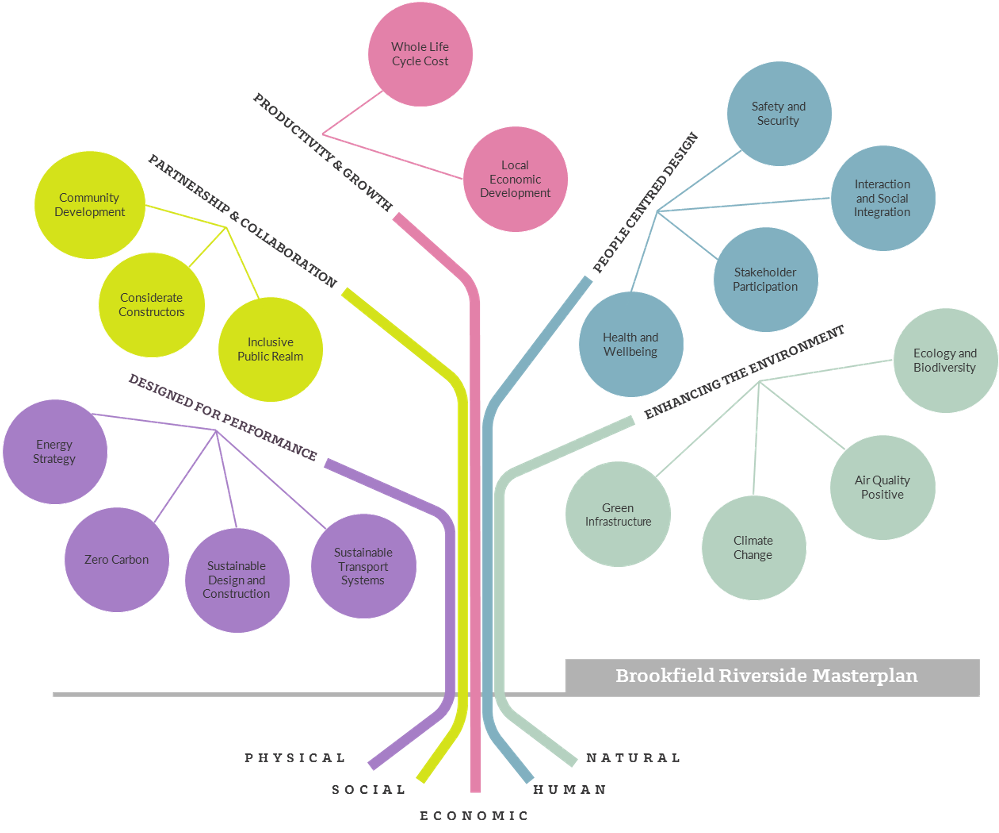Long Term Value Creation
The proposed approach for the Brookfield Riverside Masterplan is focused on creating long term value with a focus on five key aspects of sustainable development, namely: the social, economic, physical, natural and human capital. Ultimately, this is aimed at realising real term and tangible benefits for the site, community and users.
Natural capital – by enhancing the environment
Human capital – through a people centred design
Social capital – by building partnerships and collaboration
Physical capital – through facilities designed for performance
Economic capital – by driving productivity and growth
Delivery framework
The five capitals model provides a delivery framework to be championed by a specialist sustainability team. The framework will be employed to drive and monitor the uptake of applicable sustainability measures throughout the project life cycle.
Sustainability implementation plan
The sustainability framework will guide the process from establishing a vision to defining a strategy to implementing design solutions that realise value in operation. The vision, sustainability charter (including objectives and targets) will form the sustainability implementation plan (SIP) – a tool that will help drive the vision from design to construction and operation.
Sustainability initiatives and focus areas
Key initiatives and areas of focus to be championed throughout the proposed development include all of the following:
“Air quality positive”; that is, a combustion-free development, “Circular economy”; optimising the “health and wellbeing” of building occupants. Our aspirations include:
People-centred design
Health and Wellbeing
Seek WELL or Fitwel certification
Social inclusive vibrant public realm
Biophilia integration
Priority for pedestrian and cycle movement
Promoting comfort
Maximised daylight
Optimising occupant control
Spaces for people
Creation of active vibrant spaces to live, work, connect, reflect and play
Enhancing the environment
Air quality positive
‘Combustion-free’ site (building systems)
Electric Vehicle charging provision
Biodiversity net gain
Enhancement in ecology and biodiversity through landscaping strategy
Circular economy
Designing out waste (construction and operation)
Environmental benchmarking
BREEAM Excellent target (or equivalent) - Civic building
BREEAM Excellent target (or equivalent) – Retail
Partnership & collaboration
Community engagement
Create and follow a stakeholder engagement plan
Identify and assess social impacts throughout design development
Inclusive design
Incorporate inclusive design principles
Open and shared spaces
Ensure high quality public spaces that connect with surrounding transport and pedestrian links
Designed for performance
Zero carbon
Ambient energy loop driven by heat pump technology - air/ground/water source heat pumps
Integrated renewable energy generation e.g. roof or façade integrated PV
Smart demand management
Embodied carbon strategy
Transport Infrastructure
Ensure high quality and connected cycle and pedestrian routes
Productivity & growth
Whole life cycle cost
Incorporate whole life cycle thinking into cost planning
Local jobs
Focus on employing site staff from the local area
Setting targets for employing apprentices
Explore the potential to pay the Living Wage
Local suppliers
Implement sustainable procurement policies to include targets for locally sourced materials and trades

